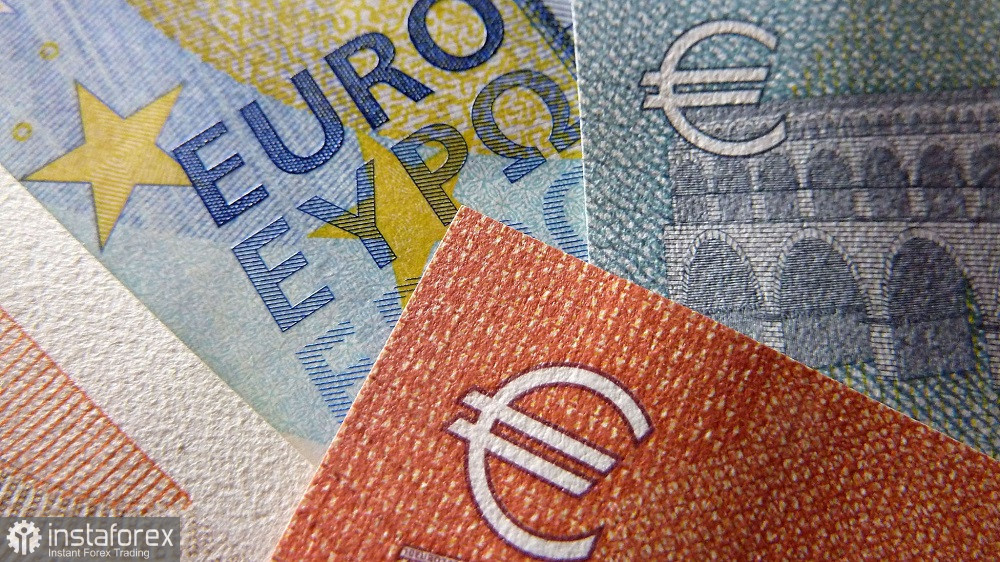The release of statistics on inflation growth in Germany provoked a strong response from the euro/dollar pair today. Given that the report was published in the "green zone," it is more likely that the ECB will continue with its aggressive stance and raise interest rates by 25 or even 50 points in May. The fundamental context is generally supportive of EUR/USD buyers. Risky asset demand isn't decreasing, European regulators are sending out hawkish signals, and inflation in Germany is slowly falling. There is only one mystery left: European inflation. The "green zone" publication of tomorrow will give EUR/USD buyers yet another justification for another northern breakthrough. Especially if the underlying PCE index, which will be released tomorrow in the US, disappoints dollar bulls.
The "green color" of the German publication caught everyone by surprise. In Germany, the total consumer price index was calculated to be around 7.4% on an annual basis, with a predicted decrease to 7.2%. Consumer prices increased by 1.1% monthly, exceeding expectations for a more moderate rise (by 0.8%) following a February increase of 1%. The European Central Bank's preferred method of measuring inflation, the Annual Harmonized Consumer Price Index (HICP), also did not match expectations. While most analysts expected it to fall to 7.4% in March, it increased to 7.8%.
All published components of the release were released in the "green zone." Although experts had anticipated a more pronounced drop in indicators, the reality is that German inflation is slowing down too slowly, seemingly confirming the ECB hawks' fears.
According to the report's structure, after rising by 21.8% in February, the price of food in Germany rose by 22.3% year over year in March. Additionally, the price of services rose (4.8% more than in February; 4.7% more). Energy costs also experienced a significant slowdown in growth; instead of growing by 19% in February, they increased by only 3.5% in March, according to the report.
In general, the German release serves as a sort of warning signal for EUR/USD traders because data on the growth of European inflation will be released exactly tomorrow, on Friday. According to early projections, the CPI in the eurozone will show contradictory dynamics: core inflation may accelerate to 5.7%, while the total consumer price index should reach 7.1% (reflecting a drop from the February 8.5% mark).
Let me remind you that ECB President Christine Lagarde used somewhat hawkish language when she spoke to the European Parliament last week. She was worried about the dynamics of inflationary growth. She claims that the eurozone's inflation rate is "still high," and the uncertainty surrounding its future course has only grown. When discussing the likelihood of further PEPP tightening, she stated that "the Central Bank would have indicated the need for further rate hikes if there were no tension in the financial markets."
Many of Lagarde's coworkers, including Knot, Muller, Kazimir, Schnabel, Lane, Nagel, and Holtzman, also made hawkish remarks. They all expressed concern over the high rate of inflation and made it clear in one way or another that they would support further rate increases if necessary.
Numerous experts, including UOB Group, predict that the ECB will raise rates by 25 basis points in response to the meeting's outcomes in May. Other analysts are certain that if core inflation in the eurozone continues to rise, the European regulator will decide on another 50-point increase. There is no agreement on the likely result of the May meeting; a lot will depend on how key inflation indicators move over time.
The German release from today tipped the scales in support of tightening the PEPP once more. It won't be a question of whether or not the Central Bank will raise the rate; rather, it will be a question of how much, if European inflation also proves to be in the "green zone" (close attention is given to the core consumer price index). Partially, buyers of the EUR/USD pair are now anticipating tomorrow's release, which almost certainly will also have a "green color."
Conclusions
Germany accounts for about 25% of all price data used to compute inflation in the eurozone, so it is not surprising that today's report caused such strong volatility for the EUR/USD pair. German data frequently correlates with European data.
The resistance level of 1.0950 (the upper line of the Bollinger Bands indicator on the daily chart) and the psychologically significant target of 1.1000 can both be tested by traders if the European report releases at least at the predicted level and the base PCE index in the US declines in the opposite direction of expectations (that is, it turns out to be below the 4.7% mark).
 English
English 
 Русский
Русский Bahasa Indonesia
Bahasa Indonesia Bahasa Malay
Bahasa Malay ไทย
ไทย Español
Español Deutsch
Deutsch Български
Български Français
Français Tiếng Việt
Tiếng Việt 中文
中文 বাংলা
বাংলা हिन्दी
हिन्दी Čeština
Čeština Українська
Українська Română
Română

